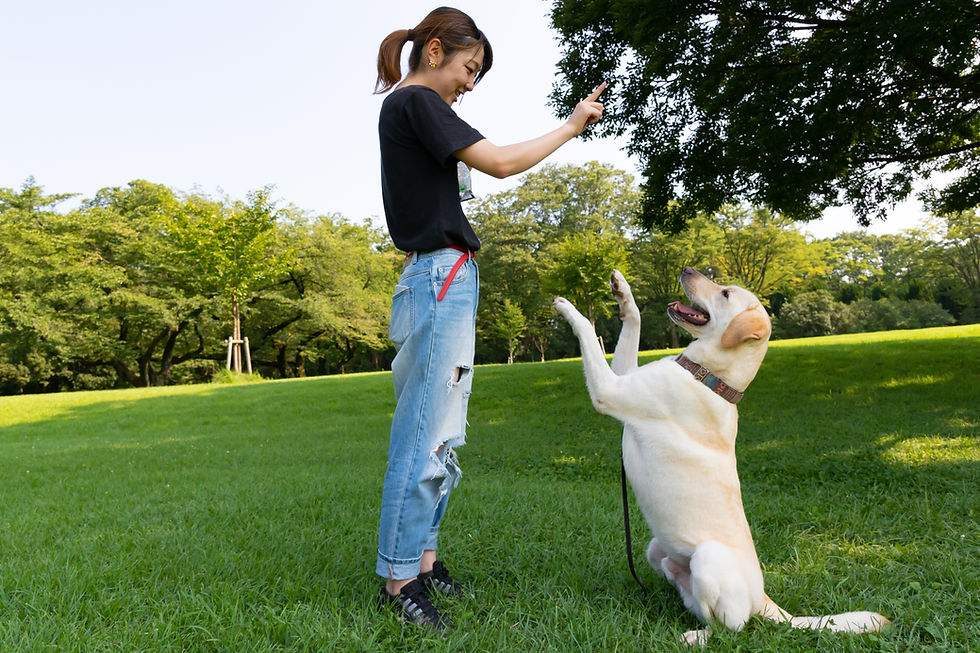Using Less Treats
- Joylynn

- Apr 1, 2021
- 3 min read
Updated: May 17, 2021

What Is fading the lure? It is the act of slowly using less and less treats when you give your dog a cue. It is often done after we proof a cue, which is covered in our previous blog posts “Rewarding Your Dog” and “Does Your Dog Know Sit?”
By fading the lure after proofing a behavior, we know how well our dog understands each cue.
Notice we are fading the lure slowly, not cutting the film mid-show!! In training we use a Signal hand and a Reward hand as a step towards success. Some dogs learn fast and tend to focus on the reward hand too much. By placing the reward behind your back, the focus is on the signal hand, and thus, the cue. This also helps in using less treats as your dog learns to perform the desired cue while the treat is not in sight. The goal is for the Clicker to take place of the treat. The best way for this to happen is to be consistent in marking a behavior.
Sit - Click - Treat!
As humans, we think of food as a reward for our dogs because we get such wonderful responses from our four legged friends when treats are used during training. However, our dogs can also see us as a reward in the 3 forms of attentions they enjoy and receive daily: we look at them, talk to them, and touch them.
Knowing what else our dog values as a reward can bring so much more to the training experience. By understanding these alternative rewards, your dog can achieve the skills we want while they are getting a reward that has more meaning than a 3 calorie nibble treat.
When out for walkies, stop every 30 ft or so to have your dog do a few skills then continue after much praise. The walk itself is a high value reward for your dog. There are smells, sights, sounds, time with you, and they get to release energy. Throwing toys are an excellent way to train without treats as well.
Remember: This isn’t about your ice cream sundae it’s about theirs. Use what your dog views as a reward, not what you think should be one.
If your dog gets bored during training (Not taking the food anymore, anticipating your cues, not focused, or only wanting to play?) This could mean they need a 10 minute walk before training to release excess energy or they need a new challenge. We call this “hitting the reset button”, it helps your dog reset their mind and prepare for training.
To take your training to the next level, try fading the lure. Each cue will take time to develop. The best way to know is to try. If they aren’t ready, or if they aren’t responding well, go back a step and keep practicing.
Another fun way to fade the lure is by doing several skills in a row before rewarding. Always mix up the skills so there is not an opportunity to guess what is coming next.
As an Example:
Sit- Down- Sit-Paw *Click & Treat* Spin-Paw-Down-Sit *Click & Treat*
Now they have to work harder for each treat and you are getting a chance to see which cues or behaviors needs individual practice. You get an “Ah-ha!” moment If your dog did not “Paw” when you cued your dog to do it both times, then “Paw” needs more work.
Timing before rewarding is another way to continue training a behavior while decreasing the treats. A dog that will ‘Come’ every time in 10 seconds now has to perform the task in 9 seconds to get the higher valued reward that is now available. This way there are still rewards, but to get the super good ones, your dog has to meet the mark.
There are reasons for continuing to carry treats with you, even after you have fully faded

treats from a cue and your dog is performing beautifully every time. We never know what we are going to encounter each day when we go into the world with our dogs. They could do something amazing that certainly deserves the best of treats. They could leave a nasty mess alone that keeps us from having to give them a bath later on. They could ‘Come’ to us in a moment that saves their life.
Treats will never 100% go away, but with timing and patience, you can definitely begin to use less!



Comments